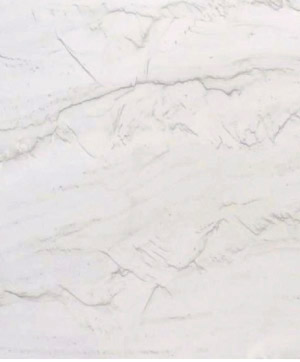Is That Marble or Quartzite?
 |
|
Mont Blanc Quartzite |
How to identify what you’re selling and installing
Frederick M. Hueston
Stone Forensics
In recent years, there have been complaints from consumers who purchase countertops from stone distributors who tell them the material is quartzite, which will not etch (a dullness of the surface) or scratch. Later, when their tops are etched and scratched, they learn the hard way that their tops are actually marble. This article explains the difference between quartzite and marble so that consumers can tell what countertop material they truly have.
About Marble
Marble is a metamorphic material that contains an abundance of the mineral calcium carbonate, which is soft and chemically reacts to acidic substances. This means marble is very susceptible to acid etch damage. Heat, pressure, and other geological forces destroy or modify the texture and structure of limestone or dolomite rock, resulting in a new form of rock known as marble. When the limestone or dolomite are very pure, the resulting marble is white. When the quartz is mixed with iron oxide or other minerals, the resulting quartzite may have streaks, lenses (transparent pieces), and varieties color.
About Quartzites
Quartzites is also a metamorphic rock, but differs from marble in that it does not contain calcium carbonate. This means it is not susceptible to acid etch damage. Quartzite is formed when heat, pressure, and other geological forces destroy or modify the texture and structure of quartz sandstone. When the quartz sandstone is very pure, the resulting quartzite is white or gray. When the quartz is mixed with iron oxide or other minerals, the resulting quartzite may have streaks, lenses, and varieties color.
Simple Tests to Determine Stone Type: Is it Marble or Quartzite?
Marble and quartzite can be very similar in appearance. Fortunately, there are a couple of simple tests one can perform to tell the difference between marble and quartzite: the scratch test and the acid test. If you attempt to perform either of these potentially destructive tests, you should obtain a sample or use a piece of scrap countertop material to perform the tests. If neither are available to you, test in an inconspicuous spot knowing that the test may cause damage.
The Scratch Test
In order to understand how the scratch test works, we need to provide a little more science. The hardness of minerals can be determined by what is called the Mohs scale of mineral hardness. This scale rates minerals from the softest mineral, being a one, to the hardest mineral, being a ten. Calcium has a Mohs hardness of three. Quartz has a hardness of seven. A standard kitchen knife has a hardness of about six.
Use a knife to scratch the surface of a countertop. The outcome indicates the hardness of the mineral. If the knife leaves a scratch, the stone is likely marble. If there are no scratches, the stone is likely a much harder stone like quartzite or granite.
The Acid Test
Calcium reacts to acids, causing etch damage. The etch may or may not have texture, depending on the severity of etch damage. Common acids will not affect quartz. Vinegar or a lemon wedge can be used for the test. Place the lemon wedge or a drop or two of vinegar on the stone and allow several minutes dwell time. Wipe up the excess. If it leaves a dull spot, that a positive indication for the presences of calcium, which indicates the countertop is marble and not quartzite.
Uh-Oh, It’s Marble
If you discovered you have marble, not quartzite, by way of these tests or because you already installed countertops that now have etch marks or scratches, rest assured that you are not doomed to replace the countertops. There are methods available to professional stone restoration contractors to hone and polish countertops, virtually erasing damage and leaving the tops with a beautiful, pristine finish. To help them stay pristine, you can also make recommendations for care and protection appropriate for the countertop material.
It is unfortunate that marbles are being sold as quartzites. While they can look similar, they do not react the same. If you are in the market for new countertops, these tests can help you make an informed decision on your investment.